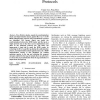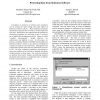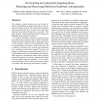832 search results - page 3 / 167 » Effect of Malicious Synchronization |
JSAC
2006
13 years 5 months ago
2006
Abstract--Wireless sensor networks have received a lot of attention recently due to its wide applications. An accurate and synchronized clock time is crucial in many sensor network...
JCM
2008
13 years 5 months ago
2008
Two effective attacks, namely de-synchronization attack and impersonation attack, against Ha et al. 's LCSS RFID authentication protocol, Song and Mitchell's protocol are...
ACSAC
2002
IEEE
13 years 10 months ago
2002
IEEE
Corruption or disclosure of sensitive user documents can be among the most lasting and costly effects of malicious software attacks. Many malicious programs specifically target fi...
SP
2010
IEEE
13 years 9 months ago
2010
IEEE
The computer systems security arms race between attackers and defenders has largely taken place in the domain of software systems, but as hardware complexity and design processes ...
ICC
2007
IEEE
13 years 11 months ago
2007
IEEE
— In the current Internet, compliance with TCP congestion control rules is voluntary. Noncompliant flows can gain unfair performance advantages or deny service to other flows. ...



